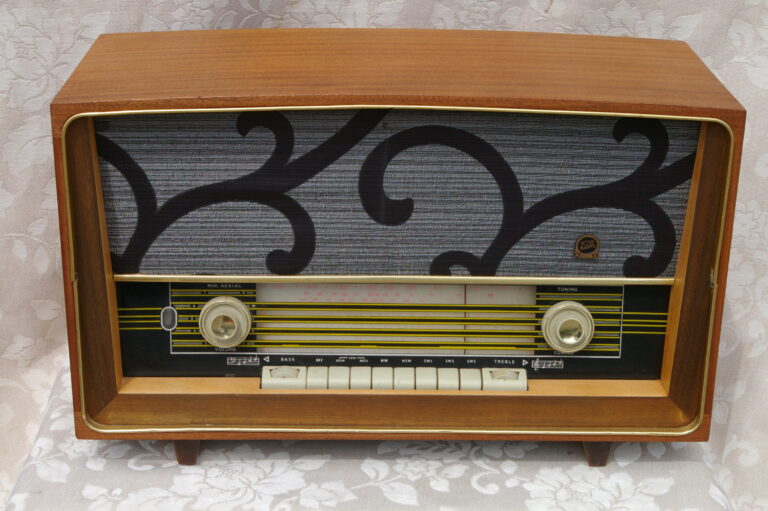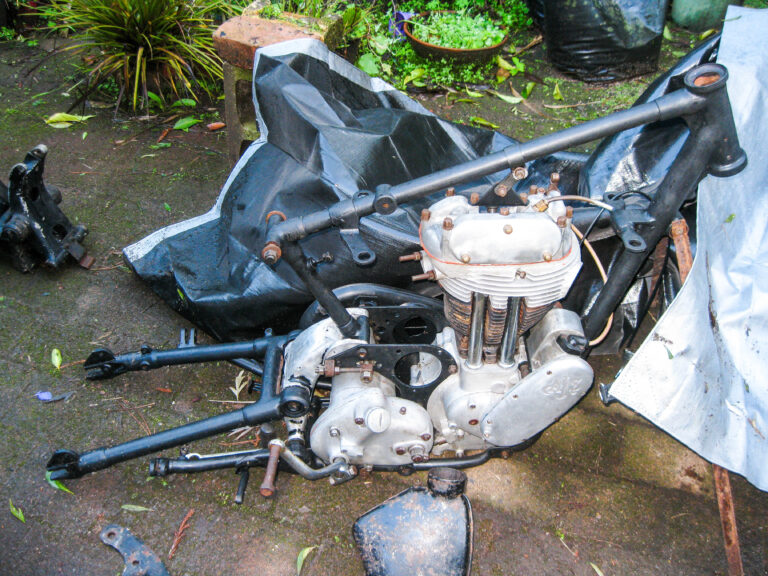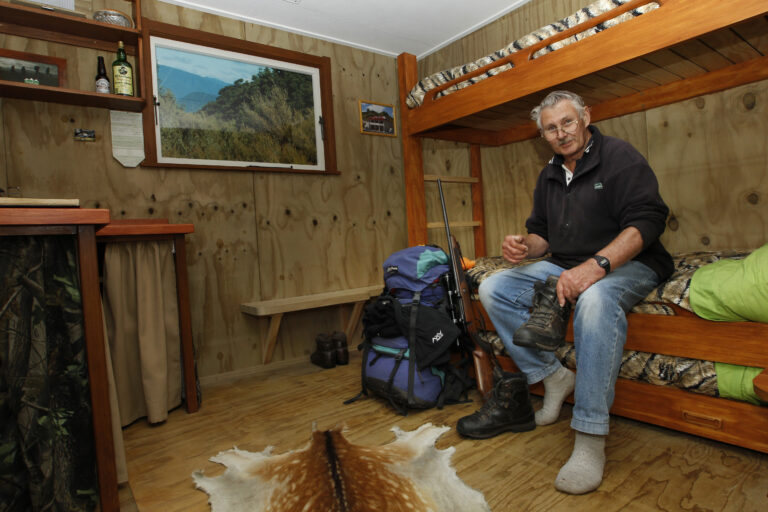Create a family book with your own design ideas
By Liz Constable
For this project to make my family history book, I am using the Coptic binding method.
Many years ago my parents owned and ran a hardware store. I worked in the shop for a short time when I arrived back in the UK after living and working in Jamaica. One day, someone came in to the shop and asked if we had a grill covering for a grid. I didn’t think I’d seen one so I went out to the back of the shop to ask Dad if we had one anywhere. As quick as a flash he whipped out a screwdriver from his trouser pocket and dashed into the backyard. He went over to the grid, removed the grill covering, cleaned and present-ed the grill to me to sell in about 30 seconds flat. I don’t know which astonishes me more when I think back to that moment; that he did it or that I just stood there and totally accepted it as normal.
I can practically hear his voice in my head now: “Never let the customer leave the shop empty-handed.”
That experience taught me well. I listen to what people ask for and provide them with what they want. Sometimes I provide them with what they didn’t even know they wanted—Pop will be proud of me for that I’m sure.
Occasionally I get asked if I restore old books or if I can bind books using the traditional methods. I point out that traditional bookbinding is an art form of its own. People train for many years to achieve the extraordinary skills required for such precise work.
So what’s the difference between traditional bookbinding and book art? As I understand it (thank you to the Association of Book Crafts), traditional bookbinding is either the restoration of old books using traditional materials and dyes and, where possible, traditional tools or it is creating new books using traditional methods.
Book art is a just-about-anything-goes form of art where a piece still functions like a book; it will open up and present a sequence of ideas, images and so on. These works are usually made by hand and are often (but not always) one-offs. A person who creates handmade books in this way is considered to be a book artist. The book artist usually binds the book by hand using a variety of creative and inventive styles of binding.
As a passion, my bookmaking is certainly the creative challenge for which I feel I’ve been preparing myself for many years. I still see myself as serving an apprenticeship at my Book Art Studios as there are so many areas of this fascinating art yet to be explored but I will continue to have many more hours following my bliss whilst I’m doing it.
The Coptic method has holes in the edge of the book board covers, so they need to be at least 3 mm thick. Inside, I’m using a mixture of black paper with white paper as an interior “margin” because I’m including writing as well photo-graphs. I like a jagged-edge look to the paper so will cut it with a wide-toothed saw, giving an impression the paper has been handmade (a deckle-edge look). You can also cut your paper with a sharp knife or serrated kitchen knife for a smaller jagged edge.
Mark cover with template
Saw gives jagged edges
Cut pages with template
Templates
A set of templates makes it easier for measuring and re-creating this book. I want this book to be a decent size so the cardboard template for front and back covers is 270 mm x 300 mm. Mark clearly on it which way is up. I name my templates and put the whole set in an envelope when the project is complete. If a template is lying around, I know instantly which set it be-longs to.
Place your template onto the book board and lightly score with a knife or pencil. Remove the template and using a sharp knife (I always begin with a fresh blade) with preferably a metal ruler, make long cuts along each edge until you feel you’ve cut through the board.
Next, make a template for the holes. Cut out a piece of paper 300 mm x 100 mm and fold it in half. With the folded edge to the left, write “top” in the top right-hand corner. Down the length of the template, draw a line 10 mm from the folded edge and second line parallel and 10 mm away from the first.
To mark the spacing of the holes down the template for the edge of the cover, draw crossways lines at 30 mm from the top, 30 mm down from this line, 135 mm from the top of the template, a fourth line 30 mm from the third line, a fifth line 75 mm from the fourth line and a sixth line 30 mm from the fifth line.
For the next template for the holes in the paper inside your book, fold in half a piece of paper 300 mm x 50 mm, write “top” in the top right-hand corner and place this on the other template.
Line the folded edge up against the first row of lines closest to the fold-ed edge of the first template. With a pencil, copy onto the second template the markings from the lines drawn width-wise across the first template. The idea is to match up the markings on both templates so that when we come to bind the cover and the pages they all line up.
Leave margin for covering
After diagonal cuts, trim with scissors.
Covering
Now is the time to cover the covers. I am using wallpaper to cover it because it’s a family book—this wallpaper has a texture like leather. I also decided to do windows for my cover, so I take that into account where the holes will be before I make the template.
I use just PVA glue—some people use PVA and wallpaper paste mixed. Fold over the corners, with a bit of glue on the edge, like a parcel. To clear the cover from the windows I make diagonal cuts first with a knife and then trim with scissors. I put the glue on the wallpaper rather than board when covering the inside as it gives you more control.
I sand the leathery cover lightly to give it more personality and cover it with a bit of coffee stain – I love coffee for colouring. You can round corners of the inside covering as an option, or sand the book corners. I have used a heat gun to bubble the cover or crinkled up the paper and ironed it to give it wrinkles. It all gives personality to the cover.
Sandpaper cover for “character”
Template marks holes
Template for cover holes.
Holes with awl
Using the holes template fit it snugly against the side of the cover. Using a sharp instrument (preferably an awl if you have one) make a total of 12 holes in the cover. The holes need to be large enough to fit embroidery needles through. Do this for the front cover and the back cover. Make sure you have the back cover facing the right way i.e. inside cover facing up. I normally press hard enough to make an impression for the holes then remove the template and continue to work on the holes taking the awl all the way through. I find this less fiddly and means I don’t have to worry about the template moving.
Next you need to make a total of six holes into the edge of the cover (for smaller books, usually four). Each hole in the edge lines up with each set of double holes already pierced in the cover.
Edge holes…
..connect with cover holes
Two needles on each thread
During binding you will be taking the needle through the edge of the book and up/down the first hole. So now is a good time to prepare the way for this using your awl. Be very gentle at this stage—don’t force it. Work the awl slowly. Prepare all the holes (front and back) of both covers.
Next, using the template for your pages make the holes in the pages using your awl. It helps to write in pencil T for top on the front of each section of ensure they stay the right way up.
I use linen thread to bind my books. I find this to be sturdy, practical and I love the fact it has been hand-dyed. For this book I will be using six needles to bind it with. Measure out 152 cm length of thread x 3—each piece of thread will have two needles, one on each end of it. I wax my thread to help avoid it splitting and makes it easier to go through the holes.
First signature
Cross-stitch in gutter.
Connect to cover
Sewing signatures
When you’ve done this take the first section or signature of papers. With one piece of thread take a needle through the bottom hole (outside in) and out through the second hole above it. Do this with the other pieces of the thread at the top holes. At this point make sure your threads are all the same size.
Take the needles and put them in the holes on the edge of the front cover (make sure your front cover is facing inside up). Your needles should come up and through the first holes. Pull them all up and then all down the second hole so that they come out onto the front. At this stage I chose to do a cross-stitch. Simply cross the needles over and push through the holes closest to the edge of the cover. Place the cover with the first signature face down. I do this next step to give the cover a little extra support.
Under stitch
Back to signature
Start back cover.
Loop
Take the bottom thread and loop it around and underneath the section. Put your needle under the thread that is in the book cover. Bring the needle down the other side back through to where you started from. Do the same with the next thread up—go outside in so that both threads end up in the middle of the two holes. Repeat this with the other needles and two holes in the middle and at the top.
Take another signature and put the needles in the outside holes at the bottom and push through. Cross them over each other and bring them out back to where you started. Repeat with all the holes. Then pull it all in so that it’s nice and tight against the cover and the first section.
Locking stitch
Now do a locking stitch very similar to the support stitch we did at the beginning. Each time you do a locking stitch you work with the last two signatures. Take the bot-tom thread and loop it around underneath the two signatures and bring it out in the gap between the signatures and in the middle be-tween the two holes. Do the same with the next needle up looping it up and around the last two signatures and bringing it out through the middle. Repeat this step with the other two.
All the threads and needles ought to be in the middle of each pair of holes in the signatures.
Take another signature and put the needles in the outside holes at the bottom and push through. Cross them over each other and bring them out back to where you started. Repeat above. Then pull it all in so that it’s nice and tight against the cover and the first section. Follow the instructions again for another locking stitch (for the last two signatures).
Each time you have finished the locking stitch you add another signature and repeat. When you have used up all the signatures your book ought to be a neatly com-pact group of sections or signatures.
STITCHING SIGNATURES
Outside in…
…back through hole
Second needle into hole…
…back through first hole
First thread locked…
Back through gap
Second needle and thread through gap…
…around existing thread
Both threads in middle.
Back cover
Place the back cover for your book with the inside facing up next to your partially finished book. Line up the thread and needles with the corresponding holes in the cover. Push the needles through the edges up into the first holes and down through the second holes. This will take the needles through to the other side of the cover. Repeat the stitch you chose to use on the front cover. You will end up with the threads and needles lying out on your work surface.
Put each needle down through the hole of the last signature so that they go through to the inside of the last signature.
Tie off your threads to the length of your choice. Congratulations and well done! You’ve now completed your book.
Back through second holes
Through hole of last signature



